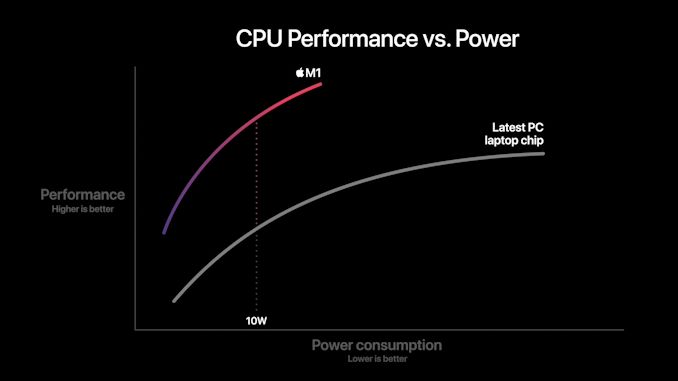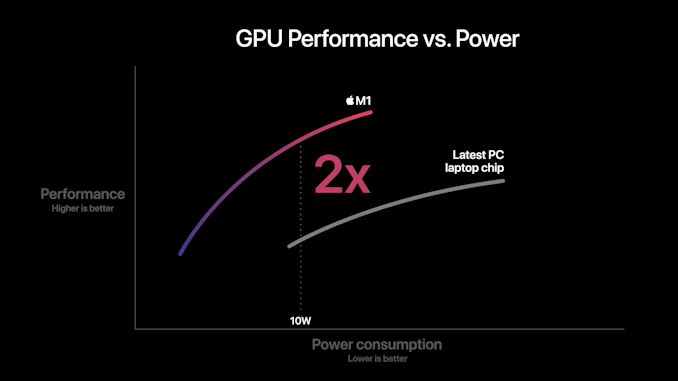Apple Announces The Apple Silicon M1: Ditching x86 - What to Expect, Based on A14
by Andrei Frumusanu on November 10, 2020 3:00 PM EST- Posted in
- Apple
- Apple A14
- Apple Silicon
- Apple M1
Apple Shooting for the Stars: x86 Incumbents Beware
The previous pages were written ahead of Apple officially announcing the new M1 chip. We already saw the A14 performing outstandingly and outperforming the best that Intel has to offer. The new M1 should perform notably above that.
We come back to a few of Apple’s slides during the presentations as to what to expect in terms of performance and efficiency. Particularly the performance/power curves are the most detail that Apple is sharing at this moment in time:
In this graphic, Apple showcases the new M1 chip featuring a CPU power consumption peak of around 18W. The competing PC laptop chip here is peaking at the 35-40W range so certainly these are not single-threaded performance figures, but rather whole-chip multi-threaded performance. We don’t know if this is comparing M1 to an AMD Renoir chip or an Intel ICL or TGL chip, but in both cases the same general verdict applies:
Apple’s usage of a significantly more advanced microarchitecture that offers significant IPC, enabling high performance at low core clocks, allows for significant power efficiency gains versus the incumbent x86 players. The graphic shows that at peak-to-peak, M1 offers around a 40% performance uplift compared to the existing competitive offering, all whilst doing it at 40% of the power consumption.
Apple’s comparison of random performance points is to be criticised, however the 10W measurement point where Apple claims 2.5x the performance does make some sense, as this is the nominal TDP of the chips used in the Intel-based MacBook Air. Again, it’s thanks to the power efficiency characteristics that Apple has been able to achieve in the mobile space that the M1 is promised to showcase such large gains – it certainly matches our A14 data.
Don't forget about the GPU
Today we mostly covered the CPU side of things as that’s where the unprecedented industry shift is happening. However, we shouldn’t forget about the GPU, as the new M1 represents Apple’s first-time introduction of their custom designs into the Mac space.
Apple’s performance and power efficiency claims here are really lacking context as we have no idea what their comparison point is. I won’t try to theorise here as there’s just too many variables at play, and we don’t know enough details.
What we do know is that in the mobile space, Apple is absolutely leading the pack in terms of performance and power efficiency. The last time we tested the A12Z the design was more than able to compete and beat integrated graphics designs. But since then we’ve seen more significant jumps from both AMD and Intel.
Performance Leadership?
Apple claims the M1 to be the fastest CPU in the world. Given our data on the A14, beating all of Intel’s designs, and just falling short of AMD’s newest Zen3 chips – a higher clocked Firestorm above 3GHz, the 50% larger L2 cache, and an unleashed TDP, we can certainly believe Apple and the M1 to be able to achieve that claim.
This moment has been brewing for years now, and the new Apple Silicon is both shocking, but also very much expected. In the coming weeks we’ll be trying to get our hands on the new hardware and verify Apple’s claims.
Intel has stagnated itself out of the market, and has lost a major customer today. AMD has shown lots of progress lately, however it’ll be incredibly hard to catch up to Apple’s power efficiency. If Apple’s performance trajectory continues at this pace, the x86 performance crown might never be regained.












644 Comments
View All Comments
timecop1818 - Saturday, November 14, 2020 - link
You were fully aware of what you were buying. Why did you even consider something with 720p screen? I have hp spectre 13" with 4k oled and it's great. It wasn't much more expensive than this thing either.Alistair - Saturday, November 14, 2020 - link
I don't care about the screen, it is hooked up to a monitor. I care about the abysmal performance. The screen has nothing to do with anything, I don't even know why you are mentioning it.Alistair - Saturday, November 14, 2020 - link
I mean, I traded the screen since it wasn't that important for the i7 upgrade for "free".Alistair - Saturday, November 14, 2020 - link
Can probably emulate Overwatch faster...Samus - Saturday, November 14, 2020 - link
How is this even possible from a CPU that is passively cooled...Alistair - Saturday, November 14, 2020 - link
Here's one reason I found out the Intel laptop is so bad. So my Tiger Lake Laptop is configured down to 18W maximum, but it doesn't say that anywhere. Intel is cheating by not calling it a "U" series part. You can't tell until you get home and install HWInfo and wonder at your low performance that your laptop is limited to 18W and not 28W.Atom2 - Saturday, November 14, 2020 - link
Perhaps it is not meaningful to use benchmarks from 2006. Apple would look even better with whatever was used in 1980s.TotalLamer - Sunday, November 15, 2020 - link
Alright, so help me out here... isn't ARM inherently unable to be as capable as x86 because it's a RISC architecture? I always took it to mean that while it's more efficient than x86 (and thus why it's used in phones) it's more limited in its abilities. Is that wrong?thunng8 - Sunday, November 15, 2020 - link
Yes it is wrongandrewaggb - Sunday, November 15, 2020 - link
It's pretty impressive. I hope Apple will eventually change their business model on the hardware side and start selling chips without requiring iphones, mac's, etc. I'm just not very interested in Mac OS and most of their hardware (other than Apple TV because the siri remote control is awesome). I'd rather run Windows and Linux and use my own case with big video cards and a half dozen drives.